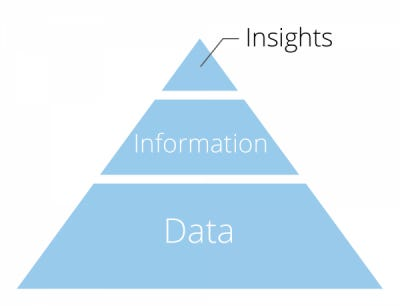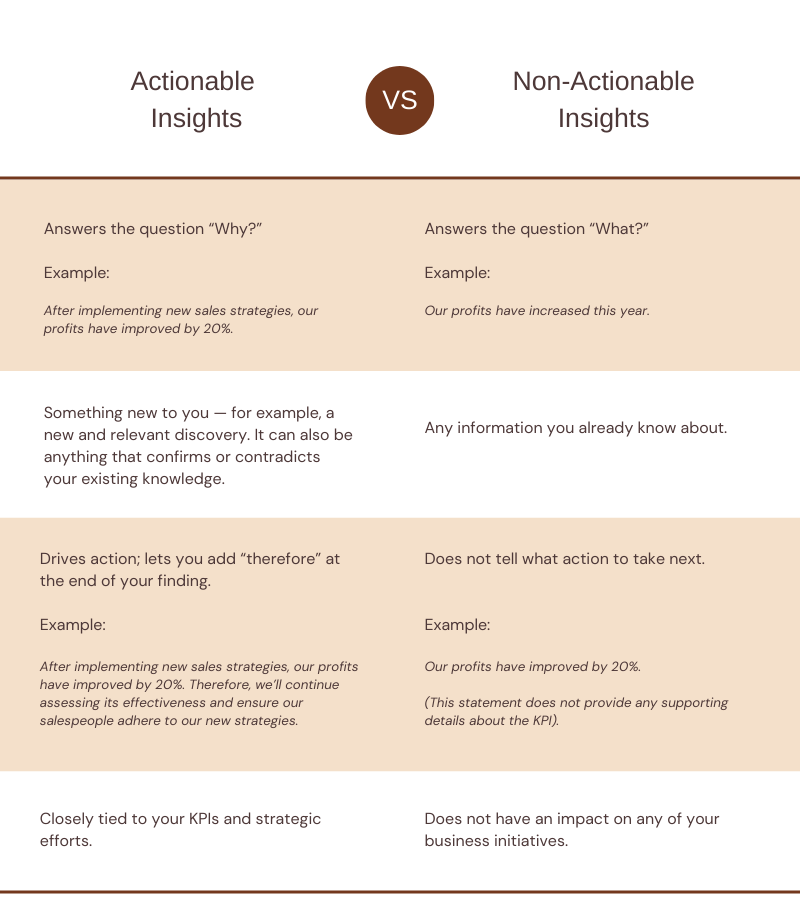What are Actionable Insights and How Can You Generate Them?
More data and more information do not always set your business up for success. What you need are actionable insights. These are meaningful findings that trigger action among key stakeholders.
To safeguard its context from overuse, let’s take a deep dive into what actionable insights are — its attributes, how to distinguish actionable from non-actionable insights, what makes insights actionable and other key information about this topic.
.jpg?width=1200&name=kelvin-han-ML0Bdrx8Go0-unsplash%20(1).jpg)
What are actionable insights?
Actionable insights are the conclusions you can acquire from enriching data with meaning and context. It sits at the pinnacle of the data pyramid — at the bottom lies raw data followed by processed information.
 Image source: Forbes
Image source: Forbes
Data refers to unprocessed facts. It usually comes in textual or numerical form. Individual data does not provide any context yet. To extract its value, you need to process, cluster, summarize and organize datasets using business intelligence (BI) or data analytics tools. The result is information that provides more context to your data. It can be presented using dashboards, data visualizations or reports.
The use of BI or data analytics software, however, is often misconstrued. In reality, “what is really being offered by many analytics solutions is just more data or information — not insights,” author and data storyteller Brent Dykes said in this Forbes article.
Information, by itself, is not yet actionable. You must still analyze and contextualize it before it can become an actionable insight.
BI tools collect, process and consolidate essential information based on your key performance indicators (KPIs). It presents information in a visualized format. Each metric answers only the “what”, as the image below shows.
.jpg?width=4688&name=stephen-phillips-hostreviews-co-uk-shr_Xn8S8QU-unsplash%20(1).jpg)
Image source: Unsplash
The dashboard above shows the total number of clicks, impressions and the average click-through rate the website has received over a certain period. It also shows its average position on the web. It does not, however, clarify what actions to take to improve the website’s performance.
You still need to analyze what triggered such results and how it can affect your organization. Has your performance improved or not? If it improved, what efforts did you make to achieve it? Can you replicate it to maintain good numbers?
To answer these questions, you need to compare your existing information with your historical data. You may also need input from other stakeholders.
In other words, BI tools provide an efficient way to process and present information. In return, it’ll be easier for humans to analyze and pull-out valuable insights that they can use to make better business decisions.
Read Next: 7 Best Approaches in Implementing Data Analytics
Actionable vs. non-actionable insights: How to tell the difference
How can you tell if an insight is actionable or not? We summarize its key differences in the table below.

What makes insights actionable?
Are your insights actionable enough to inspire your key stakeholders in making smarter decisions? Here are the elements you must look for when examining business insights, according to the data expert Brent Dykes:
1. Alignment
Insights become more actionable when they are closely aligned with your key business priorities and KPIs due to the sense of urgency it creates.
2. Context
An insight must have enough supporting details. Always provide background information, such as benchmarks, to give context to the information you present. By doing so, you can inspire more stakeholders to act instead of attracting unwarranted skepticism and objections.
3. Relevance
Always present the insight to the right person, at the right time and in the right place. In addition, do not let it stale. The insight can lose its value the longer it takes to reach the appropriate decision-makers.
4. Accessibility
Ensure that the key stakeholders in your organization know how to access BI and data analytics tools. In addition, encourage them to use these tools regularly. If needed, provide the necessary training and information-sharing among users of BI and analytics.
5. Clarity
The insights you present must always be clear and easy to understand, even for those who are not yet accustomed to data. Explain why it’s important and how it can bring improvements to the business. Whenever possible, use the right data visualizations to highlight essential information and make complex concepts easier to comprehend.
Starter’s pack for transforming data into actionable insights
Like a gem, actionable insights are rarely seen in the open. To mine these valuable insights, your organization should have the following:
1. Strong BI infrastructure
Before you can obtain valuable insights, you need a way to process your data efficiently. An internal IT team can be a good start. But if you do not have enough resources for it yet, you can opt for reliable third-party service providers to collect, store, organize and analyze your data.
2. Good data quality
Useful and accurate insights come from good data. If your database is full of incomplete, invalid or irrelevant data, then the results will also be flawed. Worse, it can even result in wrong conclusions.
Always conduct regular audits of your database to ensure you’re only dealing with good data. Also, implement quality assurance processes to validate the accuracy and timeliness of your data before it’s saved into the database.
3. Efficient data integration
Actionable insights can be generated when all relevant data is brought together for analysis.
Business intelligence tools and other cloud software allow integration. For example, you can integrate your CRM tool into your cloud accounting software. Aside from breaking down silos and making your team more efficient, integrating relevant add-ins into your main BI tool can give more context to your generated data.
4. Data experts
Despite BI’s ability to process disparate data and transform it into useful information, it still needs human assistance to extract value from data. Data presented through reports or dashboards only provide non-context information while insights come from the analysis of the data.
See to it that you work with data experts who possess excellent analytical and critical thinking skills to make sure you can use data to your advantage.
Technology can only do so much. At the end of the day, organizations still need the help of humans to do higher-level skills such as analysis and reporting.
Our accountants at D&V Philippines are adept at using business intelligence tools and data analytics software. We harness technology to generate actionable reports that can aid our clients in making smarter financial decisions.
If you’re interested in working with us, or you’d like to know more about our BI-powered accounting services, talk to our experts today. You may also download our latest whitepaper, The Rising Frontier: Harnessing the Power of Business Analytics, to learn more about our suite of business analytics solutions.




